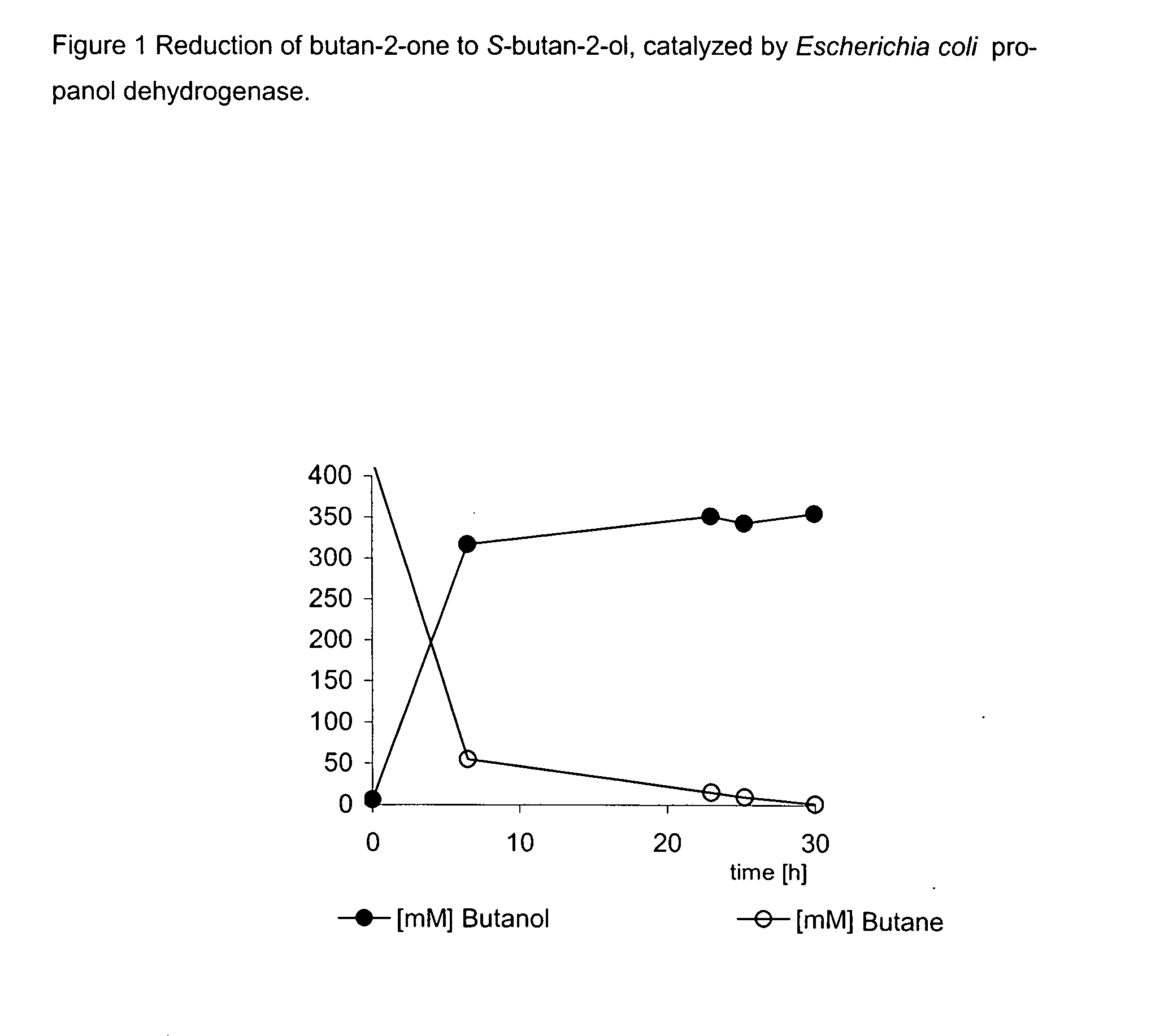Method for the Production of Optically-Active Alcohols
a technology of optically active alcohol and production method, which is applied in the direction of biofuels, enzymes, microorganisms, etc., can solve the problem of not reporting enantioselectivities
- Summary
- Abstract
- Description
- Claims
- Application Information
AI Technical Summary
Benefits of technology
Problems solved by technology
Method used
Image
Examples
example 1
Cloning of the Escherichia coli Propanol Dehydrogenase
[0099] The sequence of the gene of Escherichia coli propanol dehydrogenase has been deposited in databases (GenBank ID 48994873 region: complement (1550852 to 1551892)). Oligonucleotides which were used for amplifying the gene from Escherichia coli genomic DNA according to known processes were derived from the nucleic acid sequence of the propanol dehydrogenase gene. The sequence obtained corresponds to the published sequence. The DNA sequence of the oligonucleotides is depicted in table 1.
TABLE 1Oligonucleotides for preparing the syntheticgene of Escherichia coli propanol dehydrogenase#1GGGAATTCATATGCAGAACATCATCCGAAAAG#2CCCAAGCTTAGTGACGGAAATCAATC
[0100]
PCR conditions:2 μl10*Pfu-Ultra buffer (Stratagene ®)100 ngprimer #1 (cf. Table 1)100 ngprimer #2 (cf. Table 1)1 μldNTP (10 mM each)approx. 30 ngEscherichia coli chromosomal DNA1 UPfu-Ultra DNA polymerasead 20 μlH2OTemperature program:5 min, 95° C.,45 sec, 40° C.,1.5 min, 72° C....
example 2
Provision of Recombinant Propanol Dehydrogenase
[0103]E. coli LU12418 were grown in 20 ml of LB-Amp / Spec / Cm (100 μg / l ampicillin; 100 μg / l spectinomycin; 20 μg / l chloramphenicol), 0.1 mM IPTG, 0.5 g / l rhamnose in 100 ml Erlenmeyer flasks (baffles) at 37° C. for 18 h, centrifuged at 5000*g / 10 min, washed once with 10 mM TRIS*HCl, pH 7.0 and resuspended in 2 ml of the same buffer.
[0104] Cell-free protein crude extract was prepared by disrupting E. coli LU12418 cell paste 0.7 ml of glass beads (d=0.5 mm) in a vibratory mill (3×5 min, with intermediate cooling on ice).
example 3
Determination of the Activity of the E. coli LU12418 Recombinant Dehydrogenase
[0105] In each case 6 transformants were grown in 20 ml of LBAmp / Spec / Cm (100 μg / l Amp; 100 mg / l Spec; 20 μg / l Cm), 0.1 mM IPTG, 0.5 g / l rhamnose in 100 ml Erlenmeyer flasks (baffles) at 37° C. for 18 h, centrifuged at 5000*g / 10 min, washed once with 10 mM TRIS / HCl, pH 7.0 and resuspended in 2 ml of the same buffer. Cell-free crude extract of E. coli LU12418 was obtained by disrupting cells with 0.7 ml of glass beads (d=0.5 mm) in a vibratory mill (3×5 min, with intermediate cooling on ice).
[0106] The consumption of reduced cosubstrates during the reduction of ketones can be monitored in a photometer at 340 nm. 10 μl of diluted cell-free crude extract (≅10 μg of protein), 10 μmol of n-propanal and 250 nmol of NADH or NADPH were incubated in 1 ml of 50 mM KPi, 1 mM MgCl2, pH 6.5 at 30° C. 1 unit (1 U) corresponds to the amount of enzyme which reduces 1 μmol of n-propanal in 1 min.
PUM
| Property | Measurement | Unit |
|---|---|---|
| Fraction | aaaaa | aaaaa |
| Reduction potential | aaaaa | aaaaa |
Abstract
Description
Claims
Application Information
 Login to View More
Login to View More - R&D
- Intellectual Property
- Life Sciences
- Materials
- Tech Scout
- Unparalleled Data Quality
- Higher Quality Content
- 60% Fewer Hallucinations
Browse by: Latest US Patents, China's latest patents, Technical Efficacy Thesaurus, Application Domain, Technology Topic, Popular Technical Reports.
© 2025 PatSnap. All rights reserved.Legal|Privacy policy|Modern Slavery Act Transparency Statement|Sitemap|About US| Contact US: help@patsnap.com


